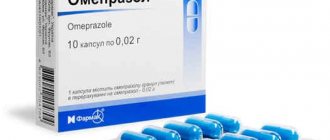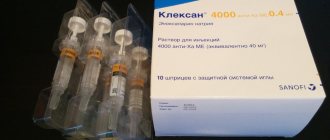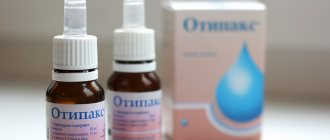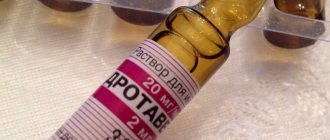The stomach is one of the most “nervous” organs in our body. And we can safely say that he is sick due to nervousness, among other things. There is even an informal term “stomach neurosis”. Therefore, when treating ulcers and gastritis, you should pay attention to your nervous system. And today in the article we will talk about the causes of gastritis and ulcers, their symptoms, and we will also talk about the well-known drug for the treatment of ulcers and gastritis - omeprazole, and how to prevent the development of diseases.
Release form and composition:
Enteric capsules, cellulose
Dosage 10 mg
1 capsule of the drug contains:
active ingredient: omeprazole 10.00 mg; substances that are used to give shape or enhance the effect: sucrose, sodium carboxymethyl starch type (A), hypromelose P, triethyl citrate 2.3 mg, titanium dioxide (E171) 0.75 mg, oleic acid 0.10 mg, potassium chloride 0, 2 mg, sodium lauryl sulfate 3.00 mg, ethyl acrylate copolymer 10.2 mg, povidone 4.75 mg, potassium oleate 0.65 mg; Cellulose capsule: carrageenan 0.15 mg, iron oxide red dye (E172) 0.6 mg, potassium chloride 0.2 mg, sunset yellow dye (E110) 0.36 mg, charming red dye (E129) 0.28 mg, purified water.
Dosage 20 mg
1 capsule of the drug contains:
Active ingredient: omeprazole 20.00 mg; substances that are used to give shape or enhance the effect: sucrose and starch syrup 96.00 mg, sodium lauryl sulfate 5.99 mg, titanium dioxide (E171) 3.6 mg, triethyl citrate 4.7 mg, carboxymethyl starch type (A) 4, 2 mg, hypromellose 6.00 mg, povidone 9.5 mg, potassium oleate 1.29 mg, oleic acid 0.215 mg, ethyl acrylate copolymer 20.46 mg; Cellulose capsule: carrageenan 0.19 mg, potassium chloride 0.27 mg, titanium dioxide (E171) 3.6 mg, hypromellose 52.05 mg, purified water, charming red dye (E129) 0.096 mg, brilliant blue dye ( E133) 0.34, sunset yellow dye (E110) 0.46 mg.
Dosage 40 mg
1 capsule of the drug contains:
Active ingredient: omeprazole 40.00 mg; substances that are used to give shape or enhance the effect: sucrose and starch syrup 174.00 mg, sodium carboxymethyl starch type (A) 8.40 mg, sodium lauryl sulfate 12.00 mg, povidone 19.00 mg, ethyl acrylate copolymer 41.00 mg , triethyl citrate 9.4 mg, titanium dioxide (E171) 3.00 mg, talc 0.4 mg, potassium oleate 2.58 mg, hypromellose 12.00 mg, oleic acid 0.43 mg; Cellulose capsule: carrageenan 0.29 mg, potassium chloride 0.4 mg, purified water, hypromellose 78.07 mg, titanium oxide (E171) 5.4 mg, brilliant blue dye (E133) 0.504 mg, sunset yellow dye (E110) 0.702 mg, charming red dye (E129) 0.15 mg.
Lyophilisate for the preparation of a solution for infusion with mint flavor
Dosage 40 mg
1 bottle of the drug contains:
Active ingredient: omeprazole 40.00 mg; substances that are used to give shape or enhance the effect: sodium hydroxide 5.3 mg, disodium edetate 1.00 mg.
White powder with a mint scent for the preparation of a suspension for oral administration
Dosage 20 mg
1 sachet of the drug contains:
Active ingredient: omeprazole 20.00 mg; substances that are used to give shape or enhance the effect: sodium bicarbonate 1680.00 mg, xylitol 2000.00 mg, sucrose and starch syrup 2070.00 mg, sucralose 30.00 mg, xanthan gum 55.00 mg, mint flavoring 30.00 mg.
Film-coated tablets
Dosage 20 mg
1 tablet of the drug contains:
Active ingredient: omeprazole 20.00 mg; substances that are used to give shape or enhance the effect: microcrystalline cellulose 220.00 mg, glyceryl monostearate 1.44 mg, hyprollose 4.8 mg, hypromellose 15.00 mg, sagnesium stearate 0.7 mg, paraffin 0.2 mg, macrogol 2.5 mg, polysorbate 0.1 mg, crospovidone 4.6 mg, sucrose 22.00 mg, titanium dioxide (E171) 2.2 mg, triethyl citrate 8.2 mg.
pharmachologic effect
Antiulcer, proton pump inhibitor - a drug that reduces the secretion of gastric glands, gastroprotective.
Pharmacodynamics
The proton pump inhibitor is a benzimidazole derivative and reduces the production of hydrochloric acid in the stomach - it stops the action of hydrogen-potassium adenosine triphosphatase in the parietal cells of the stomach and thereby inhibits the last stage of hydrochloric acid secretion. The drug is chemically modified, in a certain biological environment it turns into the drug itself and is released in the acidic environment of the zymogenic tubules of the parietal exocrinocytes. Reduces gastric secretion on an empty stomach and stimulated secretion, regardless of the type of stimulus. A block of secretion after using 20 mg of omeprazole occurs during the first hour, the maximum concentration is reached after 2 hours. Suppression of 50% of maximum secretion continues throughout the day.
A single dose of 1 capsule at a dose of 10 or 20 mg per day suggests a fairly rapid and effective decrease in acid secretion in the stomach during the day and night, reaching its highest point after 4 days of treatment and decreasing by 3-4 days after the last dose of the drug. In patients with duodenal ulcers, administration of 20 mg omeprazole maintains intragastric pH at 3.0 for a duration of 17 hours. After a course of treatment with omeprazole, daily stimulated secretion is suppressed by 100%
Pharmacokinetics
The rate of absorption is high, the maximum concentration in the blood plasma is achieved after 1-4 hours, the bioavailability of the drug is 30-40% (in case of liver diseases it increases to 100%); Having the ability to dissolve in lipids and oils, the drug easily penetrates the parietal cells of the stomach; binds to blood plasma proteins - 90-95%; the volume of liquid for distributing the substance in it is about 0.3 l/kg.
The time during which the substance loses half of its pharmacological effect is 0.5-1 hour (for liver diseases - 3 hours), the time for cleansing the body tissues of the drug is 500-600 ml/min. It is almost completely broken down in the liver with the formation of several metabolic products (hydroxyomeprazole, sulfide and sulfone derivatives, etc.). Excreted by the kidneys up to 70-80% and partially with bile 20-30%.
Treatment with omeprazole in chronic renal failure reduces its excretion in proportion to the decrease in glomerular filtration rate. In elderly patients, excretion decreases and bioavailability increases.
Brief information about the drug
Omeprazole belongs to a group of antiulcer drugs called proton pump inhibitors. Penetrating into the cells of the gastric mucosa, the active substance blocks the final phase of hydrochloric acid production. Thus, Omeprazole reduces the acidity of gastric juice, which creates all the conditions for the healing of damage and erosions of the mucous membrane.
Learn more about why Omeprazole is prescribed and what it helps with.
The medicine is produced in the form of gelatin capsules, inside of which there is granulated omeprazole.
The drug is used in the treatment of a whole list of diseases, including:
- Ulcers of the stomach and duodenum, including those arising from stress and taking non-steroidal medications;
- Reflux disease (entry of stomach contents into the esophagus);
- Zollinger-Ellison syndrome (astron-producing tumor of the pancreas or duodenum).
Contraindications to taking Omeprazole are intolerance to omeprazole itself or any of the auxiliary components, the patient's age is less than eighteen years, pregnancy and breastfeeding.
Indications for use of Omeprazole
Inside, do not chew. Capsules are taken in the morning (20-30 minutes before meals or during meals).
In elderly patients, no dose adjustment is required.
In patients with liver failure, the maximum daily dose should not exceed 20 mg.
- Omeprazole for gastritis
Prescribed only for the treatment of gastritis with high acidity. Take 1 capsule 1 time per day before meals. The course of treatment for acute gastritis is no more than 2 weeks.The dosage and duration of treatment with Omeprazole should be determined by the doctor depending on the type of disease, the severity of the patient’s condition, his age and characteristics of the body.
- Omeprazole for prevention
At a dose of 20 mg daily before the first meal, 1 time per day. - Omeprazole for heartburn
20 mg 1 time per day.For patients with severe reflux esophagitis, increase the dose to 40 mg once a day. The course of treatment is 4-8 weeks.
For long-term treatment of patients with reflux esophagitis in remission, 10 mg per day for 8-10 weeks of maintenance therapy.
For children over 2 years old and weighing more than 20 kg, it is recommended to prescribe the drug at a dose of 20 mg once a day.
The therapeutic effect appears after 15 minutes.
- Omeprazole for pancreatitis
For an acute attack of pancreatitis - 20 mg once. Drink plenty of warm water. Reception course - 2 weeksIn the chronic stage of the disease, it is recommended to take 60 mg once a day, preferably in the morning, with a capsule of plenty of warm water.
- Omeprazole for poisoning
20-40 mg per dose. No more than 80 mg per day.It is recommended to take the medicine before consuming food or alcohol. Try not to take Omeprazole before bed.
In particularly severe cases, Omeprazole is prescribed in the form of a solution for infusion of 40 mg, administered intravenously.
- Omeprazole for abdominal pain
For stomach pain, it is used in combination with other medications at a dosage of 40 mg once. The analgesic effect lasts for 18 hours.For pain in the pancreas, it is used 1-2 times a day in a wide range of doses of 20-120 mg/day, depending on the patient’s body weight and the acidity of the stomach contents. 20-30 minutes before meals. For intravenous administration, the minimum dose is 40 mg per dose. The duration of treatment is 1-2 weeks, but if indicated by a doctor, the course can be extended.
Contraindications
- Hypersensitivity to omeprazole or other components of the drug
- Co-administration with clarithromycin in patients with liver failure
- Kidney failure
- Liver failure
- Combined use with erlotinib, posaconazole, nelfinavir, St. John's wort preparations
- Genetically inherited reactions of lactose intolerance due to lack of lactase, sucrase/isomaltase, fructose intolerance, insufficient absorption of nutrients in the small intestine
- Children under 2 years of age weighing less than 20 kg
- Children under 4 years of age weighing less than 31 kg
- Age up to 18 years for all indications for use, except for GERD and duodenal ulcers caused by Helicobacter pylori
- Osteoporosis
- Concomitant use with atazanavir (the dose of omeprazole should not exceed 20 mg per day), clopidogrel, itraconazole, warfarin, clarithromycin, rifampicin, voriconazole
- Significant reduction in body weight
- Repeated vomiting
- Vomiting blood
- Swallowing disorder
- Black chair
- Vitamin B12 (cyanocobalamin) deficiency
- Increased risk of bone fractures
- Magnesium deficiency with secondary calcium deficiency
- Recurrent increase in hydrochloric acid secretion after discontinuation of the drug. Withdrawal syndrome.
Combination with other medications
Drugs whose absorption is altered by Omeprazole:
- ketoconazole;
- erlotinib;
- itraconazole;
- digoxin;
- clopidogrel.
The metabolism of drugs that are processed by the same enzyme as omeprazole may slow down:
- diazepam;
- phenytoin;
- warfarin;
- cilostazol.
Does not affect drugs such as cyclosporine, estradiol, erythromycin, budesonide, lidocaine. Caution and correction are required when prescribing tacrolimus, St. John's wort methotrexate, and rifampicin simultaneously.
Side effects
The frequency of occurrence of undesirable effects is divided into classes according to the guidelines of the World Health Organization (WHO): very often (≥1/10), often (≥1/100, <1/10), infrequently (≥1/1000, <1/100) , rare (≥1/10000, <1/1000), very rare (<1/10000).
Disorders of the blood and lymphoid system: rarely - a decrease in the number of leukocytes and platelets; very rarely - neutropenia, a significant decrease in the number of all blood cells; increase in the number of eosinophils;
Digestive disorders: often - abdominal pain, constipation, indigestion, accumulation of gases in the intestines, nausea, vomiting; rarely - thirst, gastrointestinal candidiasis, stomatitis, colitis, liver dysfunction; very rarely - the formation of glandular cysts due to blockage of the ducts of the gastric glands during prolonged use of the drug while used simultaneously with clarithromycin (benign form, reversible changes);
Respiratory system disorders: rarely - bronchospasm;
Disorders of the liver and biliary tract: infrequently - an increase in the quantitative content of ALT and AST; rarely - inflammation of the liver (with yellowing of the skin); very rarely - portosystemic encephalopathy, dystrophic changes in brain tissue in patients with existing liver diseases;
Immune system disorders: rarely - intolerance to individual components of the drug (fever, anaphylactic shock and anaphylactic reaction, angioedema)
Disorders of the mental and nervous system: often - headaches; rarely - overexcitation, confusion, depression, impaired taste perception; very rarely - aggressiveness, severe hallucinations; infrequently - insomnia, dizziness, increased sensitivity, hypersomnia;
Visual disorders: rarely - ametropia.
Disorders of the skin and subcutaneous tissues: infrequently - inflammatory skin lesions, allergic dermatosis, itching, nettle rash; rarely - baldness, increased reaction to sunlight; very rarely - target-shaped rashes on the skin and mucous membranes, malignant exudative erythema, bullous dermatitis.
Musculoskeletal disorders: rarely - fractures of the femur, wrist bones and vertebrae, mainly in patients taking high doses of the drug for a long time; very rarely - muscle pain, joint pain, myasthenia gravis.
Renal and urinary tract disorders: rarely - tubulointerstitial nephritis.
Disorders of the reproductive system: very rarely - hypertrophy of the mammary gland and underlying adipose tissue.
Hearing disorders: illusion of constant movement in space, dizziness.
Disorders at the injection site: increased sweating, local swelling, painful conditions.
Omeprazole can smooth out the symptoms of malignant neoplasms and lead to a delay in diagnosis with sudden loss of body weight, frequent vomiting, including hematemesis, and impaired swallowing.
After stopping the drug, erythema and rashes caused by hypersensitivity reactions in most cases disappear within a few days.
special instructions
The body's reaction may be inadequate to any substance, in particular the components of Omeprazole.
The drug should be used with caution in the following cases:
- pregnancy, breastfeeding;
- gastritis with low acidity;
- atrophic gastritis;
- oncology;
- osteoporosis;
- pathological manifestations in the kidneys, liver;
- salmonellosis;
- dysfunctions of the digestive tract.
Possible side effects: bloating, stool upset, nausea, vomiting.
Overdose
The drug has a fairly low level of toxicity, but with an independent increase in dosage, above the permissible doses for a particular disease, signs of increased side effects will appear.
The main symptoms will be impaired visual function, excessive agitation, confusion, drowsiness, headaches, excessive sweating, nausea and vomiting, arrhythmia, tachycardia, anorexia
If symptoms of overdose appear, immediately consult a doctor for qualified help.
There is no specific treatment, hemodialysis is not effective. Treatment is aimed at eliminating symptoms of overdose and maintaining normal laboratory values. If necessary, gastric lavage and activated charcoal are prescribed.
Interaction of Omeprazole with other drugs
- Omeprazole slows down or enhances the elimination of drugs that are oxidized in the liver (warfarin, diazepam, phenytoin).
- Plasma concentrations of atazanavir and nelfinavir may be significantly reduced when coadministered with omeprazole.
- Plasma concentrations of saquinavir and ritonavir increase to 65-70% when taken with omeprazole, which does not affect the tolerability of therapy in HIV-infected patients.
- The bioavailability of drugs whose elimination depends on acidity (iron salts) can change both up and down.
- Combination with drugs that reduce the acidity of gastric juice reduces the effect of omeprazole.
- St. John's wort preparations, when taken with omeprazole, can accelerate its breakdown, reducing the concentration of the active substance in the blood plasma.
- When using omeprazole with methotrexate, an increase in the concentration of methotrexate in the blood may be observed.
- When taking methotrexate in high doses, you should stop taking omeprazole to avoid side effects.
- When taking omeprazole with amoxicillin or metronidazole, there are no side effects.
- With long-term administration of 20 mg of omeprazole with lidocaine, caffeine, and ethyl alcohol, no changes in plasma concentrations were observed.
- The interaction of proton pump inhibitor drugs with antacids has not been analyzed.
- The attending physician should monitor patients taking phenytoin concomitantly with omeprazole, as a reduction in phenytoin dosage may be necessary.
- The use of cilostazol and omeprazole at a dosage of 40 mg 1 time per day can lead to an increase in the maximum concentration of cilostazol by 20-30%.
- When taken with clopidogrel, there may be an increased risk of blood clots in the coronary vessels of the heart.
- When omeprazole and tacrolimus are taken together, there is an increase in the plasma concentration of tacrolimus.
Omeprazole analogues
Analogues -
These are medicines that contain one active substance and differ in the components of additional substances that regulate the rate of absorption, excretion and reduce the side effects of the original drug. Their effect has been officially proven and tested.
Which is better Omeprazole or Omez?
Omez is a generic drug and does not have major differences in composition and pharmacological action with Omeprazole, however, Omez contains lactose in its excipients, which should be taken into account by people with lactose intolerance or hypolactasia. Also, Omez includes more excipients that reduce absorption and slow down the rate of reaching maximum concentration in the blood plasma.
Omez is produced in India, and Omeprazole is produced in Russia.
You will not notice a significant difference when using the original and the generic, except that the side effects, which may be more pronounced when using Omeprazole, will be slightly smoothed out when using Omez.
Both drugs are available only with a doctor's prescription.
Which is better Omeprazole or Rabeprazole?
Both drugs are proton pump inhibitors. Rabeprazole is recognized as the “gold” standard in the treatment of GERD due to its high rate of decrease in gastric secretion, which lasts up to a day with a small dosage compared to other proton pump drugs. Rabeprazole relieves pain from heartburn faster (3-4 days of treatment) than Omeprazole (5-6 days of treatment). As well as inflammatory and erosive changes in the mucous membrane of the esophagus were eliminated during treatment with Omeprazole on days 18-25, Rabeprazole on days 14-30. When Rabeprazole is discontinued, there is no sudden withdrawal syndrome or increased acidity in the stomach; it slowly recovers over 5-6 days.
Which is better Omeprazole or Famotidine?
When choosing between these two drugs, preference is given to Omeprazole, since it turns out to be more effective in treating gastric ulcers, but it also has a serious side effect in the form of the body getting used to the drug and reducing its effect on the body. In this case, the drug Omeprazole is replaced with Famotidine. Famotidine has a mechanism of action that is different from Omeprazole and is classified as an H2-antihistamine.
Famotidine is produced in the form of tablets of 20 and 40 mg.
Currently, Famotidine has faded into the background, since it affects only H2-histamine receptors and acid production in the stomach continues thanks to acetylcholine and gastrin, which are inhibited by Omeprazole.
These drugs may be co-administered when taken with antacids.
Which is better Omeprazole or Emanera?
The active substance of Emanera differs from Omeprazole - Esomeprazole. The effect after using Emanera occurs within 1-2 hours after taking one capsule. The drugs are used to treat ulcers of the stomach, esophagus and GERD. Emanera also acts as a preventive medicine for long-term use of NSAIDs and conditions with increased acid production in the stomach.
The drug Emanera is able to accumulate in the gastrointestinal mucosa and is released only when the secretion of hydrochloric acid increases.
Which is better Omeprazole or Ranitidine?
They have different mechanisms of action, but the main pharmacological effect remains the same. Ranitidine is less effective in combating hyperacidity. Ranitidine develops the body's resistance to the main substance and requires a constant increase in the dose of the drug.
Ranitidine acts for 9-12 hours and is used 2-3 times a day, regardless of the filling of the stomach and the time of meal; Omeprazole is enough to be taken once a day on an empty stomach.
Ranitidine is used for allergic reactions to the components of Omeprazole and insufficiency of the therapeutic effect of Omeprazole.
Which is better Omeprazole or Esomeprazole?
Its absorption is significantly lower than Omeprazole, since it is almost half destroyed by liver enzymes and does not reach the cells of the gastric mucosa. The use of Esomeprazole for GERD is more effective.
Which is better Omeprazole or Nolpaza?
The main substance of Nolpaza is pantoprazole sodium. The medicinal effect appears after 3 hours from the moment of administration, which is significantly lower than that of Omeprazole - 30 minutes. The contraindications and side effects of these drugs are similar, but the indications for use are much broader for Omeprazole, since it can also be used to prevent gastrointestinal diseases. In general, we can say that these drugs are interchangeable.
Which is better Omeprazole or De Nol?
The differences are the main active ingredients, De Nol consists of bismuth subcitrate and has a more astringent and antimicrobial effect. Prescribed for diseases of the gastrointestinal tract, especially for gastritis in the acute stage, gastroduodenitis and ulcers. De Nol increases the activity of gastric enzymes and helps restore and create a protective layer on the surface of the gastric mucosa. The drug does not cause resistance.
Side effects include a change in the color of the stool, they become blackened, as well as the coloring of the tongue in a dark color, which is caused by the removal of bismuth from the body. But bismuth can accumulate in the kidneys and negatively affect their function.
Omeprazole, when taken together with De Nol, can reduce the effectiveness of the second, so you should observe a time interval of an hour after taking one of the drugs.
Which is better Omeprazole or Ultop?
Ultop is actively used in the treatment and prevention of dyspepsia and peptic ulcers; its main advantage is its use in patients with impaired liver and kidney function.
The common active ingredient in the drugs is Omeprazole. But Ultop undergoes greater purification in production, which makes it the purest and reduces the number of unwanted effects in patients.
Ultop is produced in Slovenia, and Omeprazole is a domestic drug.
Ultop is contraindicated in persons with sucrose intolerance.
Which is better Omeprazole or Omitox?
The drugs have the same active ingredient. When Omitox is taken together with other drugs, it causes changes in absorption and bioavailability.
Which is better Omeprazole or Khairabezole?
Khairabezole has smaller doses of active substances, which reduces side effects in patients and ensures easy tolerability of therapy. Significantly accelerates the suppression of gastric juice secretion. Khairabezole does not suppress the medicinal activity of other drugs taken together with it. But it is not recommended to use Khairabezol for people with liver diseases, since the dosage form (tablets) is problematic to be eliminated from the body when liver function decreases.
What is better Omeprazole or Almagel?
Almagel is prescribed mainly to patients with gastritis-associated diseases of the gastrointestinal tract. When these drugs are used together, the best local and general treatment effect is achieved. Almagel helps relieve unpleasant symptoms of gastrointestinal dysfunction, and will also have an astringent effect. Almagel is prescribed 1.5 hours after meals.
Which is better Omeprazole or Kvamatel?
The main active ingredient of Kvamatel is famotidine. Its release and activation occurs a little later than Omeprazole, 1 hour after taking 1 tablet, maximum - 3 hours after taking it. Omeprazole has a detrimental effect on Helicobacter pylori, which cannot be said about Kvamatel, which cannot cope with this bacterium. It makes no sense to use it to destroy this bacterium.
In patients with a history of liver cirrhosis, dosage adjustments are necessary.
Omeprazole has greater activity in suppressing acid formation and is much better tolerated by patients.
Which is better Omeprazole or Pariet?
Pariet contains the main active ingredient - rabeprazole. It is characterized by a significantly increased speed of action on the secretory part of the gastrointestinal tract and almost does not provoke the appearance of significant side effects in young children. It has a more effective elimination of GERD symptoms compared to Omeprazole after 1-4 weeks of treatment with the drug.
For children
Omeprazole can be used in children over 2 years of age and weighing more than 20 kg, 10 mg 1 time per day for reflux of gastric contents into the esophagus (GERD), in the treatment of heartburn symptoms. The dose can be increased to 20 mg if necessary. In children over 4 years of age and weighing more than 31 kg, 20 mg 1 time per day for duodenal ulcers caused by the bacterium Helicobacter pylori, strictly under the supervision of the attending physician. The dose can be increased to 40 mg if necessary, but monitor the patient's condition.
In older children, drugs of this group work much better in terms of stabilizing the condition and relieving symptoms.
The disadvantage of Omeprazole is the dosage form in the form of capsules of 10 and 20 mg. Parents noted that young children have difficulty swallowing capsules, especially if there is a phenomenon of impaired swallowing or dysphagia.
Omeprazole and alcohol
During the treatment of gastrointestinal diseases with Omeprazole, the use of alcohol-containing substances is strictly prohibited, as they provoke an increase in the secretory function of the stomach, cause inflammation of the mucous membrane, have a reverse effect and relapse of the disease.
The side effects of the drug are enhanced by alcohol. The patient may experience nausea, vomiting, pain in the stomach and pancreas, and jaundice may also appear due to hepatitis, increased excitability of the nervous system up to a depressive state, possible formation of blood clots, impaired visual and auditory function, swelling and fever, insomnia and migraine-type headaches. If you complete therapy or alcohol consumption on time, the side effects will disappear.
Omeprazole during pregnancy
This drug is contraindicated for use in the first trimester of pregnancy due to the possible risk of giving birth to a child with heart defects. It is prescribed when the risk to the mother is greater than the harm to the fetus. While breastfeeding, you should stop taking Omeprazole as it is found in milk.
Pregnant women are prescribed 1 tablet 1 time per day at a dose of 20 mg one hour before meals. The tablet must be swallowed whole, without chewing or softening, so as not to irritate the stomach. Drink plenty of warm water.
Do not prescribe Omeprazole unless necessary.
Side effects during pregnancy may include: bowel dysfunction (constipation, diarrhea), changes in emotional background, exacerbation of gastritis, laboratory tests reveal protein in the urine, chest pain.
Doctors give preference to Almagel and Maalox, since they do not penetrate the systemic bloodstream, but act locally at the level of the damaged organ.
Terms of sale
You must have a prescription form signed by your attending physician.
Storage conditions
Enteric capsules are best stored in a dry place, protected from light and children, at a temperature not exceeding 25 °C.
Store the lyophilisate for preparing a solution for infusion out of the reach of children, protected from light and moisture, at a temperature not exceeding 25°C.
Store the powder for preparing the suspension at a temperature not exceeding 25°C, in a dry place protected from light and children.
Best before date
Do not use the drug after its expiration date.
Lyophilisate - 2 years.
Capsules - 2 years.
Powder for preparing a suspension - 2 years.
Manufacturer
Country of origin: Russia.
Reception features
Before starting treatment, you should definitely undergo a diagnosis of the condition of the stomach and intestines. This will allow us to identify those possible diseases whose symptoms are masked by Omeprazole.
The absorption of cyanocobalamin may be reduced. This should be taken into account in patients with a risk factor. The risk of gastrointestinal infections increases.
Omeprazole contains sugars and lactose, and therefore is not approved for use if the absorption or digestion of these substances is impaired. When treatment is longer than one year, the condition of the body should be monitored. Typically, this duration is typical for maintenance treatment of reflux esophagitis.
Sales and storage
Dispensed with a doctor's prescription. Store in the original package at a temperature of no more than 25 degrees. Keep out of the reach of children. Capsules are stored for three years.










